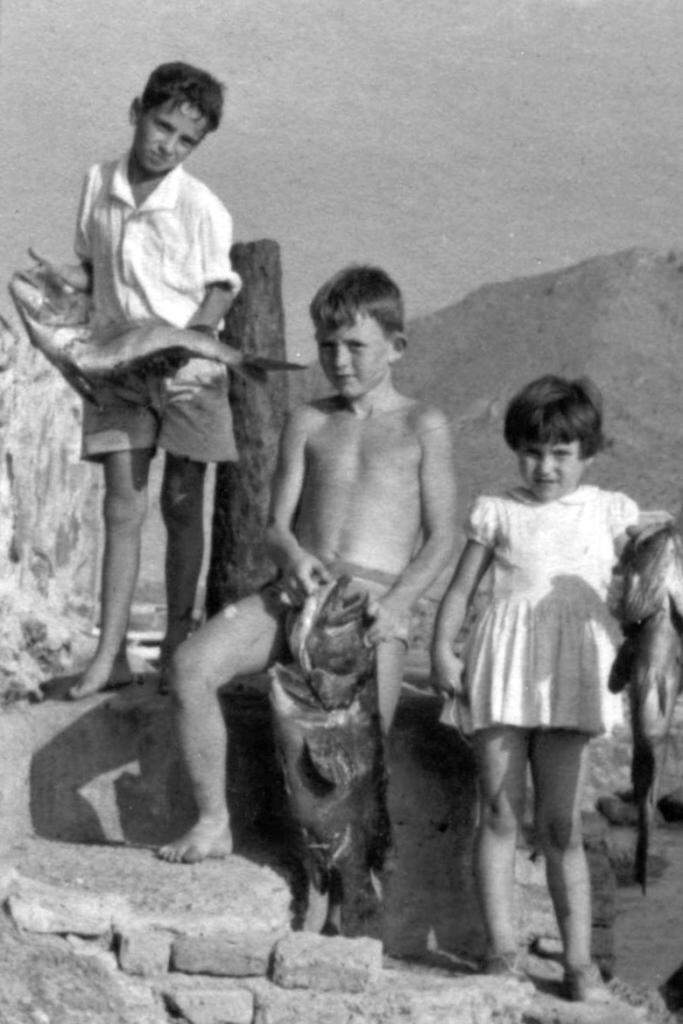
Spanish Possessions: Peñón de Vélez de la Gomera

Figure 1.--This photo was taken at Peñón de Vélez de la Gomera, one of the Spanish territories in North Africa, during 1950s. This Spanish children spent there their summer vacation. We think their fathers were probably part of the Spanish military garrison.
|
|
Peñón de Vélez de la Gomera is a small Spanish North African possession off the Mediterranean coast of Morocco. The Spanish refer to these possessions as Plazas de soberanía. The best known are the coastal cities of Ceuta (the largest Spanish possession in Morocco) and Melilla. Two other small territories deriving from medieval forts at prorcted locations are the island of Peñón de Alhucemas and Islas Chafarinas. Peñónes deriving from the Spaniish word for rock (piedra) are rock-fortresses. It is uninanited except for a Spanish military garrison. Peñón de Vélez de la Gomera is situated 119 km southeast of Ceuta. It was originally an island, making a military assault difficult, especially for attackers without a powerful navy. The geography changed somewhat as aresult of a huge storm (1934). Rocks and sand were washed up in the narrow channel between the island and the Noroccan mainland creating a land bridge. The Peñón was as a result turned into a small peninsular. Spain after taking Granada expelled both the Moors and Jews (1492). This created enormous animosity amomg the displaced Moors. Partly becauise of this, Corsairs began seizing Spanish ships and raiding Spanish settlements on Mediterranean islands and the Spanish masin;lasnd. Pedro Navarroa led a military expedition attacking the corsairs operating out of the Peñón (1508). The Spanish seized the fortress. Berbers retook the Peñón and slaugtered the defending Spanish garrison (1522). The Spanish launched several unsuccessful assaults to retake the Peñón. García Álvarez de Toledo, 4th Marquis of Villafranca, finally succeeded (1564). The Moors mounted seiges (1680, 1701, 1755, 1781 and 1790), but failed to retake the fortress. The Spanish Congress debated abandoning the Peñón as the fortress mo longer had any military significance (1871), but the measure wa another adopted. Spain and France vied over control of Morocco in the early-20th century, making any abandonment of the fortress unlikely. The Spanish and French fought a surrection in the Rif led by Abd el Krim--the Rif War (1920s). The Rifiamn forces laid seige to the fortress. The Spanish Navy using submarines were able to deliver supplies. (Germany as part of its evasions of the Versailles Treaty was assisting the Spanish Navy.) Currently a tiny military garrison of about 60 men and a few civilians are stationed there.
HBC

Navigate the Boys' Historical Clothing Web Site:
[Spanish art]
[Spanish choirs]
[Spanish ethnic groups]
[Spanish movies]
[Spanish royalty]
[Spanish school uniforms]
[Spanish youth organizations]
Navigate the Boys' Historical Clothing Web Site:
[Introduction]
[Activities]
[Biographies]
[Chronology]
[Clothing styles]
[Countries]
[Bibliographies]
[Contributions]
[FAQs]
[Spanish glossaries]
[Images]
[Links]
[Registration]
[Tools]
[Boys' Clothing Home]
Navigate the Boys' Historical Clothing national pages:
[Return to the Nain Spanish regional page]
[Return to the Main Spanish country page]
[Return to the Main countries page]
[Australia]
[Belgium]
[England]
[France]
[Germany]
[Ireland]
[Italy]
[Japan]
[Korea]
[Mexico]
[Scotland]
[United States]
Created: 8:44 PM 4/7/2010
Last updated: 8:44 PM 4/7/2010



